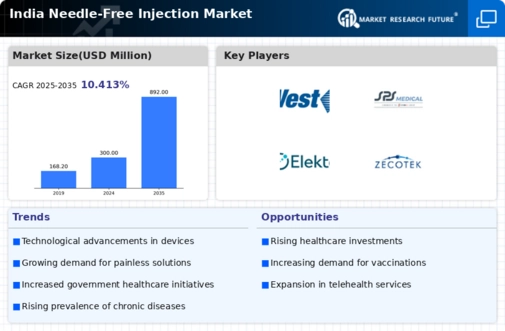Rising Healthcare Expenditure
The increasing healthcare expenditure in India is a pivotal driver for the needle free-injection market. As the government and private sectors allocate more funds towards healthcare, the demand for innovative medical solutions rises. In 2025, healthcare spending in India is projected to reach approximately $370 billion, reflecting a growth rate of around 12% annually. This financial commitment facilitates the adoption of advanced technologies, including needle free-injection systems, which are perceived as safer and more efficient. The needle free-injection market stands to benefit significantly from this trend, as healthcare providers seek to enhance patient experiences while minimizing the risks associated with traditional needle-based injections. Furthermore, the emphasis on preventive healthcare and vaccination programs further propels the need for painless and efficient delivery systems, thereby expanding the market's potential.
Supportive Government Initiatives
The Indian government is actively promoting initiatives aimed at enhancing healthcare delivery, which indirectly supports the needle free-injection market. Policies that encourage innovation in medical technologies and provide funding for research and development are crucial. For instance, the 'Make in India' initiative aims to boost domestic manufacturing of medical devices, including needle free-injection systems. This initiative not only fosters local production but also aims to make healthcare more accessible and affordable. The needle free-injection market is likely to benefit from these supportive measures, as they create a conducive environment for the development and distribution of advanced injection technologies. Furthermore, government-backed vaccination drives necessitate efficient delivery methods, further propelling the demand for needle free solutions.
Increasing Prevalence of Chronic Diseases
The rising prevalence of chronic diseases in India is a significant driver for the needle free-injection market. Conditions such as diabetes, cardiovascular diseases, and autoimmune disorders require regular medication and monitoring, often necessitating injections. The World Health Organization indicates that chronic diseases account for approximately 60% of all deaths in India, highlighting the urgent need for effective treatment solutions. Needle free-injection systems offer a convenient and less painful alternative for patients requiring frequent injections, thereby enhancing adherence to treatment regimens. The needle free-injection market is poised to expand as healthcare providers seek to improve patient outcomes and reduce the burden of chronic disease management. This trend may lead to an estimated market growth of 10% annually as more patients opt for these innovative delivery methods.
Technological Innovations in Drug Delivery
Technological innovations in drug delivery systems are transforming the landscape of the needle free-injection market. Advances in materials science and engineering have led to the development of more efficient and user-friendly needle free devices. These innovations not only enhance the efficacy of drug delivery but also improve patient safety and comfort. In India, the focus on research and development in the healthcare sector is fostering the emergence of cutting-edge needle free technologies. The needle free-injection market is likely to experience substantial growth as these innovations gain traction among healthcare providers and patients alike. The integration of smart technologies, such as digital monitoring and automated dosing, could further enhance the appeal of needle free systems, potentially leading to a market expansion of 20% over the next few years.
Growing Awareness of Needle-Free Technologies
There is a notable increase in awareness regarding needle-free technologies among healthcare professionals and patients in India. This heightened awareness is driven by educational initiatives and marketing efforts that highlight the benefits of needle free-injection systems, such as reduced pain and lower risk of needle-stick injuries. As patients become more informed about their options, they are likely to prefer needle free solutions, thereby driving demand within the needle free-injection market. Additionally, healthcare providers are increasingly recognizing the advantages of these systems in improving patient compliance and satisfaction. The market is expected to witness a surge in adoption rates as more practitioners advocate for needle-free alternatives, potentially leading to a market growth rate of 15% annually over the next few years.















Leave a Comment